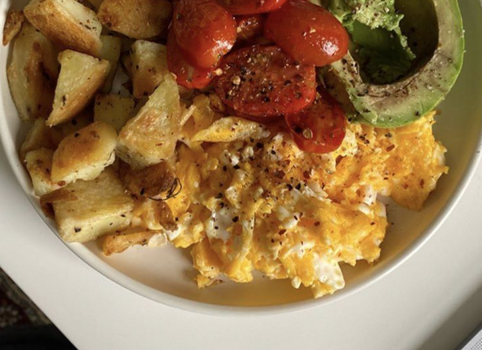The Definitive Guide to Healthy Grocery Shopping
Before you go
While some people can go grocery shopping without a list or an idea of which meals they’ll cook during the coming week, most people need some sort of a plan.
Bringing along a grocery list or a weekly menu is a good idea if you get easily side-tracked in the store or don’t know where to begin.
Creating a healthy shopping list
A grocery list is an essential tool for many shoppers. It can help you stay on task and remind you of the items you need. Plus, studies show that grocery lists may help you make healthier choices while shopping (1Trusted Source, 2Trusted Source).
But what does a “healthy” grocery shopping list include?
Generally, a healthy, well-rounded diet should primarily comprise whole, nutrient-dense foods. I’m talking about foods such as veggies, fruits, protein sources like fish and eggs, beans, nuts, and seeds. These are foods to prioritize on your list.
When creating your shopping list, it can be helpful to break it into sections, such as nonstarchy and starchy vegetables, fruits, beans and grains, nuts and seeds, proteins, frozen foods, dairy and nondairy substitutes, drinks, condiments, and miscellaneous items.
Here’s an example of what a healthy grocery list might include:
- Fruits: apples, blueberries, clementines, grapefruits, and avocados
- Nonstarchy vegetables: broccoli, asparagus, onions, spinach, peppers, and zucchini
- Starchy vegetables: sweet potatoes, baby red potatoes, and butternut squash
- Beans and grains: chickpeas, brown rice, black beans, and quinoa
- Proteins: eggs, canned salmon, skin-on chicken breast, and pea protein powder
- Frozen foods: frozen mixed berries and frozen kale
- Nuts and seeds: roasted almonds, pumpkin seeds, and natural peanut butter
- Dairy and nondairy substitutes: cashew milk, coconut milk, feta cheese, and full fat Greek yogurt
- Condiments: olives, sun-dried tomatoes, salad dressing, olive oil, pesto, and salsa
- Drinks: unsweetened coconut water and sparkling water
- Miscellaneous: ground coffee, dried fruit, dark chocolate, banana plantain chips, and shredded unsweetened coconut
You won’t have to purchase shelf-stable items like peanut butter, protein powder, and bulk grains every grocery trip. I cover how to stock your kitchen with long-lasting items further down this article.
For more detailed healthy shopping list ideas, check out this article.
Planning a weekly menu
If you prefer, you can bring a weekly menu to the store instead of a regular shopping list. This menu can list which ingredients you need to make the meals you’d like to cook the week ahead.
For example, if you’re a fan of meal prepping, try printing out the recipes you’re planning to make. Then, simply shop off of the ingredient lists.
Keep in mind that if you’re used to eating out or ordering in for most meals, trying to suddenly prepare all of your meals and snacks at home might not be realistic. Thus, if you’re new to meal prepping, start slowly and make it a goal to prepare just a few meals the first week.
Once that becomes a habit, you can add more meals to your weekly cooking menu. Like all healthy habits, it may take some time before regularly going grocery shopping and preparing healthy meals at home becomes a part of your routine.
At the store
Now that you know how to properly prepare for grocery shopping and stock your kitchen, let’s talk about healthy grocery shopping.
Ideally, you’ll want to focus on the following when grocery shopping:
- purchasing mainly whole, nutrient-dense foods
- shopping off of your list or weekly meal plan
- avoiding purchasing foods solely based on the packaging
- reading the nutrition labels and ingredient lists of packaged foods
- sticking to your plan and trying to avoid impulse purchases
Unfortunately, most grocery stores are not designed to encourage healthy eating. Instead, they’re laid out to nudge you to purchase certain items — and these are not always healthy.
For example, grocery stores tend to offer sales on and create displays of ultra-processed products like refined snack foods and soft drinks. You’ll often find these at the end of aisles and checkout counters (4Trusted Source, 5Trusted Source, 6Trusted Source, 7Trusted Source).
If you have a plan, you’re less likely to get distracted by sales and displays. Simply make a point to stick to your shopping list.
Finally, trying to only grocery shop when you’re not hungry may help you avoid making impulse purchases.
How to navigate grocery aisles
Perimeter shopping — or focusing on buying foods located on the outer edges of grocery stores — can help you make healthier choices, as fresh fruits, veggies, proteins, and other perishables are often found there.
Still, you can find many healthy choices in the center aisles, including bulk grains, nuts, seeds, nut butters, canned foods, condiments, and frozen foods.
Just because an aisle features some highly processed food choices, you don’t need to avoid the entire aisle. Sometimes, aisles contain a mix of nutritious and highly refined food choices. For example, a snack-food aisle could offer nuts and seeds along with chips and cookies.
Start by filling your cart along the perimeter of the store with fruits, veggies, proteins, and other perishable items on your list. Then, move into the inner aisles for items like nuts, whole grains, and canned goods.
How to read labels
Just because an item is packaged, it’s not necessarily unhealthy. Still, it’s a good idea to read the ingredient labels and check the nutrition facts of packaged items.
Even though unhealthy, highly processed foods usually have a long list of ingredients, the same can be said for certain nutritious packaged foods. Thus, it’s important to take a look at the ingredient label before you decide whether to purchase an item or leave it on the shelf.
If the first few ingredients are a type of sweetener, refined grains, or highly processed oil, it’s usually a no-go for me.
I pay the most attention to the added sugar content of a food item. Consuming too much added sugar can harm your overall health and increase the risk of conditions like heart disease, mental health disorders, and type 2 diabetes (8Trusted Source, 9Trusted Source, 10Trusted Source, 11Trusted Source, 12Trusted Source).
For example, I recently noticed a premade chai latte product at the grocery store. I was shocked to see that it contained a whopping 31 grams, or nearly 8 teaspoons, of added sugar per 3/4-cup (180-mL) serving (13).
While the packaging mentioned words like “organic” and “gluten-free” to make you think it could be healthy, sugar syrup was listed second on the ingredient list (13).
When you’re shopping for items that usually contain some added sugar, like granola or cereal, a good tip is to opt for products that contain less than 6 grams (1.5 teaspoons) of added sugar per serving.




